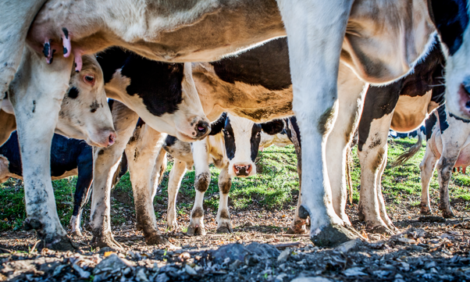



Managing Cows According to Condition Score Can Improve Profitability
UK - Managing suckler cows according to their condition score can have a huge impact on herd output and profitability, according to Dr Basil Lowman, Beef Specialist with SAC Consulting, a division of SRUC (Scotland’s Rural College).In two short videos launched today by Quality Meat Scotland (QMS), Dr Lowman demonstrates how and why to condition score and also emphasises the importance of using this key management tool at this time of year, for both spring and autumn calving herds.
The fact that cows which are too thin or too fat are more likely to have calving problems and be less fertile is well known, but there is huge potential for many more farmers to be effectively managing their herds according to cow condition score.
“The national herd goes from lean to fat on an annual basis depending on grass growth and forage quality, and condition scoring simply reflects this. It is the variation within herds which is most important for farmers to deal with," observed Dr Lowman.
He points out that the vast majority of herds have cows with condition scores ranging from two to four. This difference is equivalent, in terms of energy available to the cow, to three big bales of silage.
"Many farmers do not appreciate what a dense source of energy body fat is. Achieving the correct score at calving and mating will reduce feed costs as well as maximising output and potential."
The most crucial aspect of condition scoring, according to Dr Lowman, is that farmers take action once they have condition scored their cows. He said: "In the simplest form, farmers should take food from the fat to feed the thin in order to even out condition scores and improve productivity."
Dr Lowman continued: "Correct management at the critical stages of mating and calving offers huge benefits to output and profitability."
He also points out that there are simple techniques, such as dividing sheds using electric fence tape, which can allow farmers to group cows according to condition.
He points out that long calving periods can make cow management tricky and, instead of following a whole-herd feeding policy, his advice is to divide the herd into those due to calve in the first month and later calvers.
He reckons this split would normally be roughly two-thirds/one-third, and ideally the larger portion of the herd should be grouped according to condition score and fed accordingly.
He also points out that it is always worthwhile dealing with even a small number of overly thin or fat cows as, without attention, they are likely to be barren.
The time of calving is important in setting condition scoring targets, as this can have an impact on fertility and how receptive the cow is to mating.
Dr Lowman explains that cows calving in early spring should ideally have a score of 2.5 at calving because they are generally bulled as soon as they go out to grass so need to be in reasonable condition at turn out.
However, those calving in late spring can afford to be leaner at a score of 2 as they will have the benefit of being bulled after a month or more on spring grass when it is at its best, and fertility peaks with the cows on a rising plane of nutrition.
Autumn calvers generally find it more difficult to put on weight over the winter, and Dr Lowman recommends a calving condition score closer to 3 to allow for some weight loss before bulling.
However, he warns: "The leaner a cow is, down to a score of 2, the more easily she will calve, so only target a score of 3 in the autumn if the cows and bull both have easy-calving characteristics, otherwise aim for 2.5 and provide a high-energy feed post-calving to compensate."
The target score at mating should be 2.5, regardless of the time of year, but Dr Lowman emphasises that a cow can put on half a score at grass and lose quarter of a score on winter forage within a month.
In the new videos, Dr Lowman also advises farmers to handle 10 to 20 per cent of the cows in the herd, as visual assessment can be misleading due to gut shape and hair. Once they have a feel for the scores then the rest of the herd can be analysed visually.
Click here to watch the videos.
TheCattleSite News Desk


